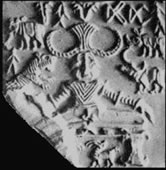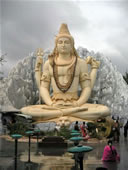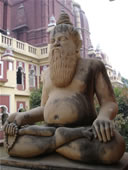

|

|

|

|

|

|

|

|
|
~~~~~~ World Bibliography of Beliefs, Theories and Theologies ~ click pix to enlarge ~~~~~~ Yoga Statue of Shiva performing Yogic meditation. Yoga is a group of ancient spiritual practices originating in India. (see pix) According to Gavin Flood, Academic Director of the Oxford Centre for Hindu Studies it has been defined as referring to "technologies or disciplines of asceticism and meditation which are thought to lead to spiritual experience and profound understanding or insight into the nature of existence." Yoga is also intimately connected to the religious beliefs and practices of the other Indian religions. Outside India, Yoga is mostly associated with the practice of asanas (postures) of Hatha Yoga or as a form of exercise, although it has influenced the entire Indian religions family and other spiritual practices throughout the world. |

|

|

|
|
Hindu texts discussing different aspects of yoga include the Upanishads, the Bhagavad Gita, the Yoga Sutras of Patanjali, the Hatha Yoga Pradipika, the Shiva Samhita, and many others. Major branches of Yoga include: Hatha Yoga, Karma Yoga, Jnana Yoga, Bhakti Yoga, and Raja Yoga. Raja Yoga, established by the Yoga Sutras of Patanjali, and known simply as Yoga in the context of Hindu philosophy, is one of the six orthodox (astika) schools of thought. Etymology The Sanskrit term yoga has a wide range of different meanings. It is derived from the Sanskrit root yuj, "to control", "to yoke", or "to unite". Common meanings include "joining" or "uniting", and related ideas such as "union" and "conjunction". Another conceptual definition is that of "mode, manner, means" or "expedient, means in general". History of Yoga Indus Valley seals A seal from the Indus Valley Civilization, showing a figure in meditation posture.Several seals discovered at Indus Valley Civilization (c. 3300-1700 BC) sites depict figures in a yoga or meditation like posture. There is considerable evidence to support the idea that the images show "a form of ritual discipline, suggesting a precursor of yoga" according to archaeologist Gregory Possehl. He points to sixteen other specific "yogi glyptics" in the corpus of Mature Harappan artifacts as pointing to Harappan devotion to "ritual discipline and concentration." These images show that the yoga pose "may have been used by deities and humans alike." Possehl suggests that yoga goes back to the Indus Valley Civilization. The most widely known of these images was named the "Pashupati seal" by its discoverer, John Marshall, who believed that it represented a "proto-Shiva" figure. Many modern authorities discount the idea that this "Pashupati" (Lord of Animals, Sanskrit pasupati) represents a Shiva or Rudra figure. Gavin Flood also characterizes these views as "speculative", saying that it is not clear from the ’Pashupati’ seal that the figure is seated in a yoga posture, or that the shape is intended to represent a human figure. Authorities who support the idea that the ’Pashupati’ figure shows a figure in a yoga or meditation posture include Archaeologist Jonathan Mark Kenoyer, current Co-director of the Harappa Archaeological Research Project in Pakistan and Indologist Heinrich Zimmer. In 2007, terracotta seals were discovered in the Cholistan Desert in Pakistan. Punjab University Archaeology Department Chairman Dr. Farzand Masih described one of the seals as similar to the previously discovered Mohenjodaro seals, with three pictographs on one side and a "yogi" on the other side. Literary sources See also: History of Yoga Ascetic practices (tapas) are referenced in the Brahma?as (900 BCE and 500 BCE), early commentaries on the vedas. In the Upanishads, an early reference to meditation is made in Brihadaranyaka Upanishad, one of the earliest Upanishads (approx. 900 BCE). The main textual sources for the evolving concept of Yoga are the middle Upanishads, (ca. 400 BCE), the Mahabharata (5th c. BCE) including the Bhagavad Gita (ca. 200 BCE), and the Yoga Sutras of Patanjali (200 BCE-300 CE). Bhagavad Gita The Bhagavad Gita (’Song of the Lord’), uses the term yoga extensively in a variety of senses. Of many possible meanings given to the term in the Gita, most emphasis is given to these three: Karma yoga: The yoga of action Bhakti yoga: The yoga of devotion Jnana yoga: The yoga of knowledge The influential commentator Madhusudana Sarasvati (b. circa 1490) divided the Gita’s eighteen chapters into three sections, each of six chapters. According to his method of division the first six chapters deal with Karma yoga, the middle six deal with Bhakti yoga, and the last six deal with Jnana (knowledge). This interpretation has been adopted by some later commentators and rejected by others. Yoga Sutras of Patanjali In Indian philosophy, Yoga is the name of one of the six orthodox philosophical schools. The Yoga philosophical system is closely allied with the Samkhya school. The Yoga school as expounded by Patanjali accepts the Samkhya psychology and metaphysics, but is more theistic than the Samkhya, as evidenced by the addition of a divine entity to the Samkhya’s twenty-five elements of reality. The parallels between Yoga and Samkhya were so close that Max Müller says that "the two philosophies were in popular parlance distinguished from each other as Samkhya with and Samkhya without a Lord...." The intimate relationship between Samkhya and Yoga is explained by Heinrich Zimmer: These two are regarded in India as twins, the two aspects of a single discipline. Sa?khya provides a basic theoretical exposition of human nature, enumerating and defining its elements, analyzing their manner of co-operation in a state of bondage (bandha), and describing their state of disentanglement or separation in release (mok?a), while Yoga treats specifically of the dynamics of the process for the disentanglement, and outlines practical techniques for the gaining of release, or ’isolation-integration’ (kaivalya). The sage Patanjali is regarded as the founder of the formal Yoga philosophy. The Yoga Sutras of Patanjali are ascribed to Patanjali, who, may have been, as Max Müller explains, "the author or representative of the Yoga-philosophy without being necessarily the author of the Sutras." Indologist Axel Michaels is dismissive of claims that the work was written by Patanjali, characterizing it instead as a collection of fragments and traditions of texts stemming from the second or third century. Gavin Flood cites a wider period of uncertainty for the composition, between 100 BCE and 500 CE. Patanjali’s yoga is known as Raja yoga, which is a system for control of the mind. Patanjali defines the word "yoga" in his second sutra, which is the definitional sutra for his entire work: ( yogas citta-v?tti-nirodha? ) - Yoga Sutras 1.2 This terse definition hinges on the meaning of three Sanskrit terms. I. K. Taimni translates it as "Yoga is the inhibition (nirodha?) of the modifications (v?tti) of the mind (citta)". Swami Vivekananda translates the sutra as "Yoga is restraining the mind-stuff (Citta) from taking various forms (Vrittis)." Gavin Flood translates the sutra as "yoga is the cessation of mental fluctuations". A sculpture of a Hindu yogi in the Birla Mandir, DelhiPatanjali’s writing also became the basis for a system referred to it as "Ashtanga Yoga" ("Eight-Limbed Yoga"). This eight-limbed concept derived from the 29th Sutra of the 2nd book became a feature of Raja yoga, and is a core characteristic of practically every Raja yoga variation taught today.The Eight Limbs of yoga practice are: (1) Yama (The five "abstentions"): nonviolence, truth, non-covetousness, chastity, and abstain from attachment to possessions. (2) Niyama (The five "observances"): purity, contentment, austerities, study, and surrender to god (3) Asana: Literally means "seat", and in Patanjali’s Sutras refers to seated positions used for meditation. Later, with the rise of Hatha yoga, asana came to refer to all the "postures" (4) Pranayama ("Lengthening Prana"): Prana, life force, or vital energy, particularly, the breath, "ayama", to lengthen or extend (5) Pratyahara ("Abstraction"): Withdrawal of the sense organs from external objects. (6) Dharana ("Concentration"): Fixing the attention on a single object (7) Dhyana ("Meditation"): Intense contemplation of the nature of the object of meditation (8) Samadhi ("Liberation"): merging consciousness with the object of meditation They are sometimes divided into the lower and the upper four limbs, the lower ones being parallel to the lower limbs of Hatha Yoga, while the upper ones being specific for the Raja yoga. The upper three limbs practiced simultaneously constitute the Samyama. It details every aspect of the meditative process, and the preparation for it. The book is available in as many as 40 English translations, both in-print and on-line. Hatha Yoga Pradipika Hatha Yoga is a particular system of Yoga described by Yogi Swatmarama, a yogic sage of the 15th century in India, and compiler of the Hatha Yoga Pradipika. Hatha Yoga is a development of - but also differs substantially from - the Raja Yoga of Patanjali, in that it focuses on shatkarma, the purification of the physical as leading to the purification of the mind (ha), and prana, or vital energy (tha). In contrast, the Raja Yoga posited by Patanjali begins with a purification of the mind (yamas) and spirit (niyamas), then comes to the body via asana (body postures) and pranayama (breath). Hatha yoga contains substantial tantric influence, and marks the first point at which chakras and kundalini were introduced into the yogic canon. Compared to the seated asanas of Patanjali’s Raja yoga which were seen largely as a means of preparing for meditation, it also marks the development of asanas as full body ’postures’ in the modern sense. Hatha Yoga in its many modern variations is the style that most people actually associate with the word "Yoga" today. Because its emphasis is on the body through asana and pranayama practice, many western students are satisfied with the physical health and vitality it develops and are not interested in the other six limbs of the complete Hatha yoga teaching, or with the even older Raja Yoga tradition it is based on. Yoga in other traditions Yoga and Buddhism Yoga is intimately connected to the religious beliefs and practices of the Indian religions. The influence of Yoga is also visible in Buddhism, which is distinguished by its austerities, spiritual exercises, and trance states. Yogacara Buddhism Yogacara (Sanskrit: "Practice of Yoga [Union]" ), also spelled yogachara, is a school of philosophy and psychology that developed in India during the 4th to 5th centuries. Yogacara received the name as it provided a yoga, a framework for engaging in the practices that lead to the path of the bodhisattva. The Yogacara sect teaches yoga in order to reach enlightenment. Ch`an (Zen) Buddhism Zen (the name of which derives from the Sanskrit "dhyana" via the Chinese "ch’an") is a form of Mahayana Buddhism. The Mahayana school of Buddhism is noted for its proximity with Yoga. In the west, Zen is often set alongside Yoga; the two schools of meditation display obvious family resemblances. This phenomenon merits special attention since the Zen Buddhist school of meditation has some of its roots in yogic practices. Certain essential elements of Yoga are important both for Buddhism in general and for Zen in particular. Tibetan Buddhism Yoga is central to Tibetan Buddhism. In the Nyingma tradition, practitioners progress to increasingly profound levels of yoga, starting with Maha yoga, continuing to Anu yoga and ultimately undertaking the highest practice, Ati yoga. In the Sarma traditions, the Anuttara yoga class is equivalent. Other tantra yoga practices include a system of 108 bodily postures practiced with breath and heart rhythm. Timing in movement exercises is known as Trul khor or union of moon and sun (channel) prajna energies. The body postures of Tibetan ancient yogis are depicted on the walls of the Dalai Lama’s summer temple of Lukhang. Yoga and Tantra Tantrism is a practice that is supposed to alter the relation of its practitioners to the ordinary social, religious, and logical reality in which they live. Through Tantric practice an individual perceives reality as maya, illusion, and the individual achieves liberation from it. This particular path to salvation among the several offered by Hinduism, links Tantrism to those practices of Indian religions, such as yoga, meditation, and social renunciation, which are based on temporary or permanent withdrawal from social relationships and modes. During tantric practices and studies, the student is instructed further in meditation technique, particularly chakra meditation. This is often in a limited form in comparison with the way this kind of meditation is known and used by Tantric practitioners and yogis elsewhere, but is more elaborate than the initiate’s previous meditation. It is considered to be a kind of Kundalini Yoga for the purpose of moving the Goddess into the chakra located in the "heart," for meditation and worship. Goal of Yoga There are numerous opinions on what the goal of Yoga may be. Goals can range from improving health and fitness, to reaching Moksha. Within the monist schools of Advaita Vedanta and Shaivism this perfection takes the form of Moksha, which is a liberation from all worldly suffering and the cycle of birth and death (Samsara) at which point there is a realisation of identity with the Supreme Brahman. For the dualistic bhakti schools of Vaishnavism, bhakti itself is the ultimate goal of the yoga process, wherein perfection culminates in an eternal relationship with Vishnu or one of his associated avatars such as Krishna or Rama. |
©